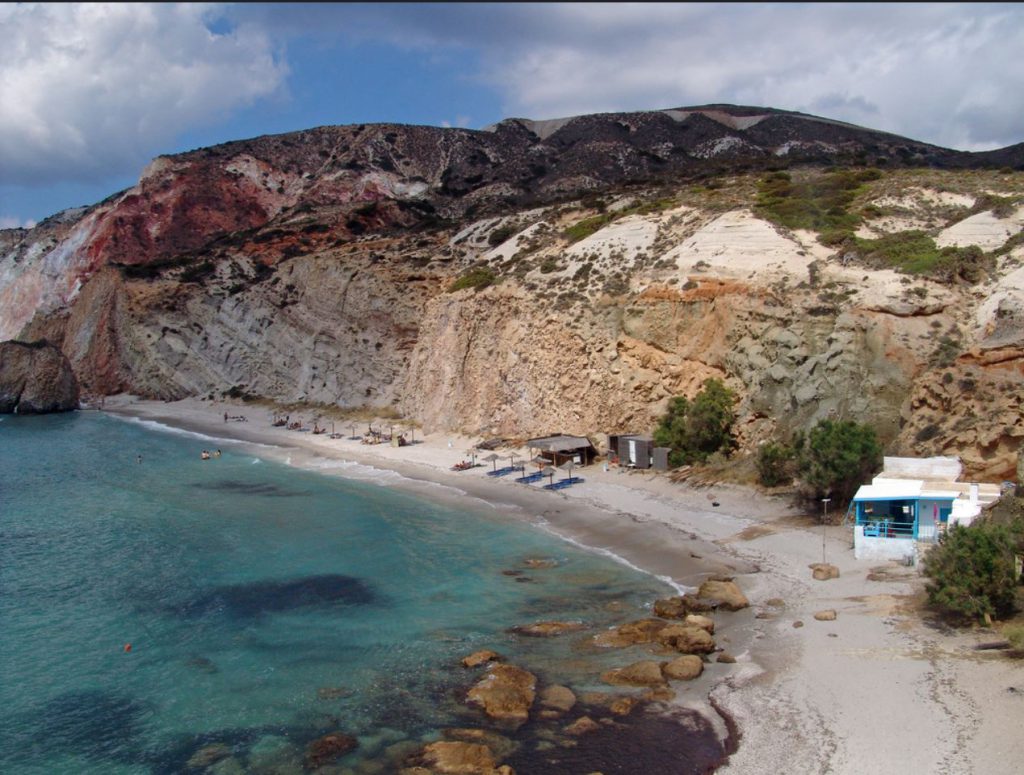Best Things to Do in Milos
Introduction
A volcanic island with a big natural harbor and rich geology, Milos has been mined for millennia for minerals and materials like obsidian, sulfur, and gypsum. The island’s geology gives rise to coastal sights that photos can’t do justice, like Sarakiniko and Kleftiko, and the kind of beaches that can make you gasp. In the Bronze Age, Milos was home to the city of Phylakopi on its north coast, which was the most significant port in the Aegean at the time. Later, Ancient Klima was the place where the Venus de Milo was found in 1820. This iconic work of art was produced in the 2nd century BC, and a copy cast from the original in the Louvre is on show at the Archaeological Museum.
Let’s explore the best things to do in Milos:
Kleftiko
From the port in Adamas, you can set sail for the southwestern corner of Milos, where one of Greece’s most photographed natural wonders awaits. Kleftiko is an arena of white cliffs and outcrops you can only reach on the water. At the base of the cliffs and rocks are caves and natural arches, and one has a cave that you’ll pass right through and look up at the captivating layered rock that forms the ceiling. Like all of Milos, these rocks have volcanic origins, and because of their pillar-like appearance, they’re compared to the cliff-top monasteries at Meteora. The name “Kleftiko” is rooted in the word “to steal” from when pirates would hide out in these caves.
Sarakiniko

If you’ve looked at any tourism material for Milos, you’ll have seen images of this alien environment on the island’s north coast. But you have to go to Sarakiniko in person to gauge the full otherworldly beauty of the place. The sea and wind have molded Sarakiniko’s bone-white volcanic rocks into sinuous humps and columns. With no sign of vegetation, Sarakiniko is like a moonscape, and you’ll want to explore for as long as possible, taking photos of the white rocks and crystalline, blue-green sea. There’s a long, shallow inlet with a beach at one end and tiered white stones along the edge where people sunbathe and dive into the water.
Firiplaka Beach

One of a chain of inviting beaches on the remote south coast, Firiplaka is hemmed by eye-catching cliffs streaked with red, brown, and yellow. The sand at their foot is pale and fine-washed by the surf, which is primarily calm unless a southerly wind blows. On all other days, kids will be perfectly safe playing in the water, which is no more than thigh-deep for some distance. On the east side is a beach bar with blocks of sunshades and loungers to rent. The cliffs bulge out in the middle, dividing the beach into two. At this point, a humungous rock with a crack in the middle opens to a cave in the water.
Milos Mining Museum

The island has a mining heritage as old as the Neolithic Period when it was an obsidian source for the entire Mediterranean. Later, Pliny the Elder wrote that Milos provided more Sulphur than anywhere in the ancient world, while it was also highly valued for its rich alum deposits. That mineral history is recorded at this museum in Adamas, summarizing all the rocks and minerals mined here down the ages, like gypsum, Sulphur, baryte, perlite, bentonite, alum and millstones. Also interesting is the set of prehistoric obsidian tools and weapons. You can see these substances still play a role in everyday life and get up to speed on mining technology in the 21st century. In the projection room, you’ll hear accounts from miners from different eras.
Paliochori Beach

Chances are you’ve never had a bathing experience like Paliochori before. Some way southeast of Zefiria, this beach has a mix of dark golden sand and shingle and is bounded by stratified rocks with red and yellow blotches. These are laced with Sulphur ore, and there’s a light smell of Sulphur in the air. Stepping into the transparent water, you may sense that it is hot. That’s because of the many hot springs that bubble below the water’s edge. At Paliochori, you’re close to a dormant volcano, and at the restaurants on the beach, you can order food cooked with volcanic heat.
Catacombs of Milos

Comparable to the catacombs of Rome and the Mount of Olives in Jerusalem, this network of underground galleries near Trypiti is an early Christian burial site. The Catacombs date from the 1st century AD and were rediscovered in 1840 and excavated shortly after by the esteemed German archaeologist Ludwig Ross. To date, three sets of tunnels have been discovered totaling more than 180 meters, where 2,000 Christians were interred in the cavities in the walls or the ground in graves covered with makeshift rocks. Only two short sections can be visited, but that’s enough to get a sense of the place and decipher inscriptions on the walls that go back 2,000 years.
Ancient Theatre of Milos

No more than 200 meters from the Catacombs is a theatre with tiers of pristine Parian marble seats facing the natural harbor and the dark outline of the hills on the west side. The location alone is enough reason to come. Belonging to the ancient town of Klima, the theatre would have first been built in Hellenistic times in the 3rd century BC and had to be reconstructed after the Athenians razed the city in Roman times. The theatre is hewn from the hill, and up to eight tiers of a monument that could once seat 7,000 spectators (compared to 700 today) have been excavated. Don’t forget to test the acoustics and search for the faint vestiges of ancient Klima’s walls and towers nearby.
Milos Archaeological Museum

From the 3rd millennium until the 12th century BC, Milos had the most important harbor in the Aegean, at Phylakopi in the north of the island. During excavations at the end of the 19th century, this site yielded outstanding Early Cycladic, Minoan, and Mycenaean artifacts, and many of these pieces are in Room 2 at the archaeological museum. There’s patterned pottery, figurines, a bathtub, and the compelling Lady of Phylakopi, a shrine from the 14th century BC. In the entrance hall stands a copy of the Venus de Milo, where there’s also a burial jar from the 6th century BC and obsidian tools made on the island. Rooms 3 and 4 have later Geometric, Archaic, Classic, Hellenistic, and Roman-era finds like tools, coins, statues, votive steles, tomb reliefs, and tables with the island’s own “Melian alphabet.”
Plaka Castle

At the village of Plaka on the east flank of the harbor, you’ll come to a narrow stairway trailing up the slope. After some effort, this will deposit you at the second-highest peak on Milos at the site of a 13th-century Venetian Castle. Plaka castle was a refuge from pirate attacks, and even if not much is left today, you have to go to the top to see a panorama of the whole island. As you climb, you’ll pass two lovely whitewashed churches, Panagia Skiniotissa and Panagia Thalassitra. The stairway gets crowded just before dusk when people scramble to see one of the most magical sunsets in Aegean.
Paliorema

This beach may not be easy to get to, as you have to take a dirt track through rugged hills for a few kilometers east of Zefiria, but you won’t regret the journey once you get there. Paliorema is more than just a place to sunbathe and swim because the ghostly ruins of a Sulphur mine are the beach. This was in business for roughly 100 years from the middle of the 19th century, and you can find out about the harrowing working conditions at the Milos Mining Museum. Also at the museum are the tokens that the miners used to buy food from the shop at the mine. As for the site, there are seams of Sulphur in the rocks, and you can venture around rusting pieces of heavy machinery, rails with wagons, a waterfront loading crane, cave houses, and the entrances to tunnels.
Tsigrado Beach

A small cove at the bottom of red and yellow cliffs, Tsigrado Beach, is not for people afraid of heights or with impaired mobility. Unless you arrive by water, the only way down onto this beach is via a steep and narrow crevasse in the rock. There’s a rope to cling onto; a ladder will get you down the final few meters. A sign at the top of the cliff warns you to make the descent at your own risk. And yet dozens of sun-seekers go down every day, and that’s because the beach is glorious. There’s quite a large patch of sand, while the glistening water is an arresting shade of turquoise. You can also wade around to a little cave, where the sunlight in the water illuminates the walls.
Cave of Sykia

Like Kleftiko, Sykia can only be approached by boat, and you will generally stop here on the way to its more famous neighbor. Sykia is a collapsed sea cave with a small shingle beach in a breathtaking cauldron of textured white rock. The light created by the water and this white stone is a joy to behold. Usually, your tour boat will wait outside the entrance to the cave, and you’ll go inside on an RIB to take a dip in the sparkling blue water and take snaps of the beach.
Trypiti Village

Walking distance from Plaka and the Catacombs, Trypiti is a traditional village arranged in tiers on the hillside and commanded by the Church of Agios Nikolaos. These houses were built on the ruins of Ancient Klima and are where the Venus de Milo came to light in 1820. Along the ridge in the upper part of the village is a line of historic windmills, built in this elevated position to catch the breeze but now converted to accommodation with incredible harbor vistas. Like Plaka Trypiti, it is a gorgeous place to watch the sun setting over the island’s natural harbor.
Adamas World War Two Bomb Shelter

In 1941, Milos was a foothold for the Wehrmacht to launch their Invasion of Crete, and a few bunkers like this one in Adamas were excavated to offer protection for personnel and store resources and equipment. Adamas is the largest of all and was used as a shelter by many of the island’s inhabitants during an Allied bombardment in 1944. For just €2, you can negotiate the bunker’s long tunnels and 12 chambers. Taking advantage of the atmospheric setting, the bunker is a gallery with graffiti, paintings, and imaginative installations.
Firopotamos Beach

Like any other beach on the island, Firopotamos is a beach and a tiny fishing port. This adds another charm to the scene, as the whitewashed fisherman’s houses come right down to the water, and the ground floors have blue-painted doors for their “syrmata,” where the boats are stored. The beach has a blend of pebbles and white sand, and being in a cove away from the open sea, the water is clear and has a dreamy shade of light blue. At the tip of the headland on the eastern entrance to the cove are some ruins for share-worthy photos.










